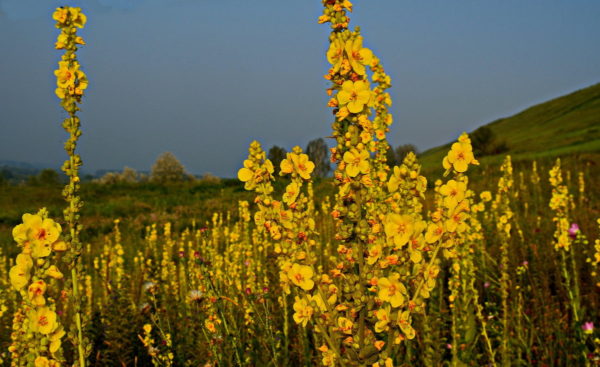Solid, obstinately staring up “scepters”, shoals of mullein, richly covered with “jewels” of large bright flowers, it is simply impossible not to notice.
And the man said: first - the elegant appearance of the plant, and then - and the benefits they bring. And considerable, because it supplies bees with good-quality, high-quality pollen. The health and joy of life returns to the person, the milk at the sudden disappearance of the cows (hence the traditional Russian name).
Table of contents
Description and characteristics of the flower Mullein
As a king, by virtue of his magnificent posture, does not get lost even in the thickest crowd, so the mullein is always a head taller than his entourage.When it is found everywhere in the wild, it simply protrudes from the thickest grass thickets in a meadow, the edge of a forest, or in a clearing above a precipice.
Species name: the scepter is given to the plant not by chance. Due to short pedicels like buds, the flowers appear imbedded in the body of the stem. And thanks to the blunt-conical form of the flowering ear, the similarity is further enhanced. It is wider at the top, in the zone of ongoing flowering, and significantly already at the bottom, where the ovaries have already formed.
Bracts of long-pointed form either protrude significantly above the level of buds or are equal in length to the petals.
The mullein flowers are large, with a diameter of 35 to 50 mm, five-petal, growing in groups of bunches, with a shiny metallic sheen. And also with all the properties of the flowers of the Norichnikov family: with two front bare stamens, while the rear stamens have dense pubescence.
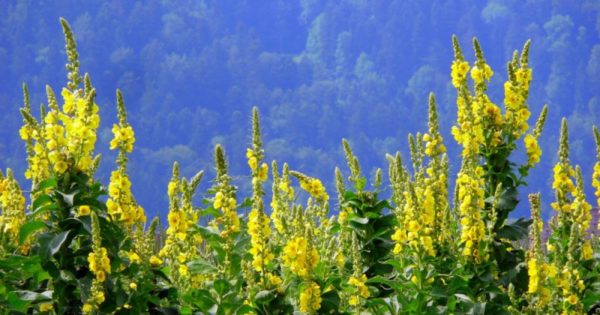
In addition to the elements of the flower (corolla, pistil and stamens), the pubescence with soft felt grayish-yellow or grayish color is also characteristic of all green parts of the plant. Especially - the leaves, due to the shape and "shaggy" which The plant is also commonly called “bear's ear” and fur coat.
If there are several stems, a real Taj Mahal arises with a higher (up to 120 cm) solid central stem, the “minaret” and slightly distant, arranged in a circle with similar “structures”. But of lesser height, with stems, the bases lying on the ground, and then rising upwards with a smooth arc.
Stem leaves are also sessile, oval, with a tendency to increasingly sharpen the shape when approaching the top. The upper leaf blades have an edge crenated-serrate, the lower ones - with a large-toothed-serrated edge.
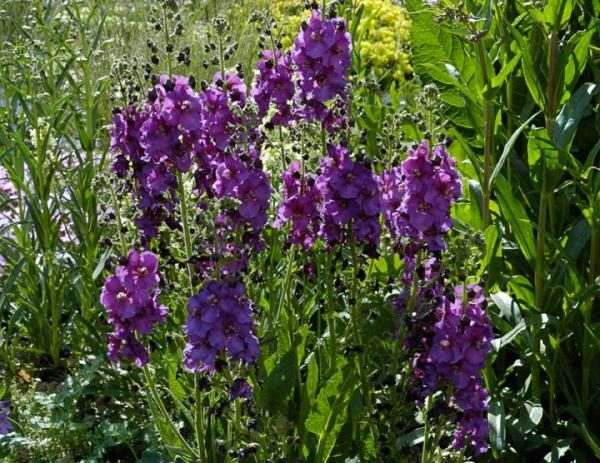
The main types of plants
In addition to the scepter-type mullein (either ordinary, or densely flowered, or tall), there are other types of it. At least 46 species grow in Russia, of which the most widespread are:
- Violet;
- Olympic;
- the black;
- paniculate, or mealy.
On the same meadow, you can easily find 3 or 4 species of mullein at once. And due to the unpretentiousness of the growing conditions, all these herbaceous perennials can be successfully planted in the garden.
Blooming from July to September Olympic mullein it is distinguished by a large capacity of densely branched, upright stems with numerous branches, giving the plant the appearance of a candelabra.
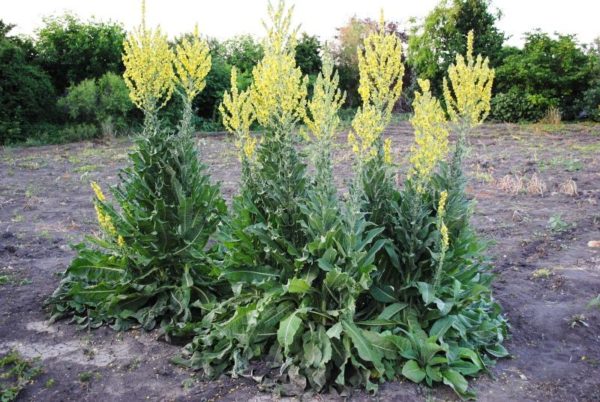
Bottom rosette - very high density due to the large number of leaves, gradually thinning above, where they smoothly pass into the zone of bracts - “wrapper” for bright golden-yellow, medium-sized (diameter of not more than 2-3 cm) flowers.
The variety is drought-resistant, high (up to -23 ° C) frost resistance, which does not require shelter for the winter.
The species of powdery mealy (biennial, blooming in July-August) with a height of 50-150 cm differs from the scepter with greater airiness and delicacy of the structure, relatively modest dimensions, strong branching of the stem with smaller flowers (also yellow) and due to pale gray green pubescence color strongly resembles wormwood.
For black mullein (50-100-120 cm in height) with the general similarity of the structure, the arrow-shaped shoots are characteristic (stems are thin, straight, directed vertically upwards) with their coloring in a blackish-reddish shade (hence the name) with an abundance of yellow flowers with violet-pink stamens . The flowering is almost uniform from top to bottom, but with the traditional “topping” of the stem from the area of compact unopened buds.
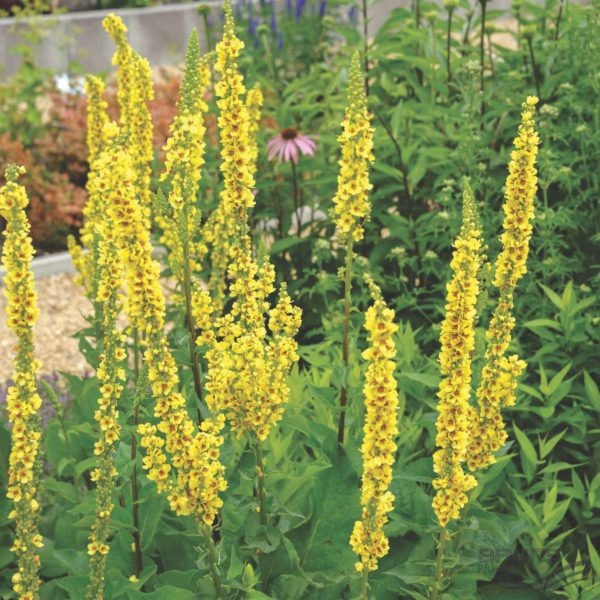
Shape purple mullein strikingly different from the previous species in the color of the whole plant in a black and purple range, single flowers, gathered in a very rare brush on a not too high (not more than 1 m), almost leafless stem.
In culture - an annual, appreciated by gardeners for their high decorative effect. Artificially derived varieties of the most diverse colors - from pure white to intense pink and violet.

Useful properties and possible harm
In order to apply this genus of plants with benefit,they do not have to be planted on the plot: it is enough for beekeepers to collect a high “harvest” of pollen and honey to take an apiary to a flowering meadow, and in case of sickness of cattle (“opoya” from a horse, loss of milk from a cow, cough from sheep), it is sufficiently collected in nature raw materials.
The therapeutic effect of the flower is also wide. For the preparation of teas, decoctions, tinctures, the above-ground parts of plants (mostly the tops of the stems with flowers) are quickly dried in a warm shade, collected in clear dry weather.
Raw materials containing mucus-forming substances, carbohydrates, essential oils, rich in vitamin C and organic acids, are used to treat both animals and humans.

This is an area:
- catarrhal diseases with dry cough and difficult sputum discharge;
- inflammatory conditions of the stomach and intestines, due to their sluggish motility and peristalsis, as well as an insufficient amount of mucus;
- cardiac pathology - alkaloids of this group of plants stimulate the activity of the heart muscle and contribute to an increase in blood pressure;
- conditions caused by an excess of water and salts in the body (edematous syndrome in case of kidney disease and other pathology).
In veterinary medicine galenic preparations of powdery mealy, oriental and violet mullein with cardiotonic effect are used, and in order to obtain the effects of diuretic, cardiotonic and stimulating motility of the stomach and intestines - extracts from purple mullein.
The effect of mullein per person
The influence of mullein on human life is great and diverse. This will help his own body, and ill livestock, and create a supply of high-grade food for bee colonies for the whole long winter.
And yet it is an incomparable aesthetic pleasure from the contemplation of beauty and the variety of shades and forms of this absolutely unpretentious kind of plants. So let them always be with the person.
